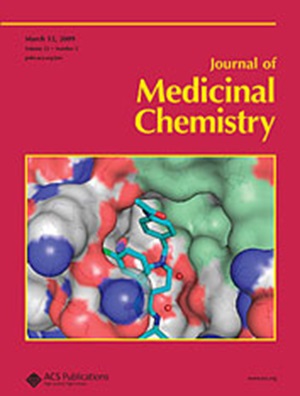通过化学方法和阳离子两亲性溶瘤肽的组合开发有效和选择性的抗癌疗法
IF 6.8
1区 医学
Q1 CHEMISTRY, MEDICINAL
引用次数: 0
摘要
本研究探讨了阳离子型两亲性Mastoparan AF衍生物的构效关系,并与溶瘤肽LTX315联用增强其抗癌功效。原始肽经过修饰,以提高其与癌细胞膜的选择性相互作用,从而增加抗癌效力,同时最大限度地减少溶血活性。利用圆二色光谱和分子动力学模拟来评价其结构变化和自缔合倾向。在这些衍生物中,MAF-10L具有优异的抗癌活性,但会升高溶血,通过与LTX315联合治疗可减轻溶血。这些发现强调了阳离子两性肽作为选择性抗癌治疗基础的潜力,并强调了肽组合在减少不良反应和提高治疗效果方面的益处。本文章由计算机程序翻译,如有差异,请以英文原文为准。

Developing Potent and Selective Anticancer Therapy through Chemical Approaches and the Combination of Cationic Amphipathic Oncolytic Peptides
This study explores the structure–activity relationships of cationic amphipathic Mastoparan AF derivatives and their combination with the oncolytic peptide LTX315 to enhance the anticancer efficacy. The original peptide was modified to improve its selective interaction with cancer cell membranes, thereby increasing anticancer potency while minimizing hemolytic activity. Circular dichroism spectroscopy and molecular dynamics simulations were employed to evaluate structural changes and self-association tendencies. Among the derivatives, MAF-10L exhibited superior anticancer activity but elevated hemolysis, which was mitigated through combination therapy with LTX315. These findings underscore the potential of cationic amphipathic peptides as a basis for selective anticancer treatments and highlight the benefits of peptide combinations in reducing adverse effects while enhancing the therapeutic efficacy.
求助全文
通过发布文献求助,成功后即可免费获取论文全文。
去求助
来源期刊

Journal of Medicinal Chemistry
医学-医药化学
CiteScore
4.00
自引率
11.00%
发文量
804
审稿时长
1.9 months
期刊介绍:
The Journal of Medicinal Chemistry is a prestigious biweekly peer-reviewed publication that focuses on the multifaceted field of medicinal chemistry. Since its inception in 1959 as the Journal of Medicinal and Pharmaceutical Chemistry, it has evolved to become a cornerstone in the dissemination of research findings related to the design, synthesis, and development of therapeutic agents.
The Journal of Medicinal Chemistry is recognized for its significant impact in the scientific community, as evidenced by its 2022 impact factor of 7.3. This metric reflects the journal's influence and the importance of its content in shaping the future of drug discovery and development. The journal serves as a vital resource for chemists, pharmacologists, and other researchers interested in the molecular mechanisms of drug action and the optimization of therapeutic compounds.
 求助内容:
求助内容: 应助结果提醒方式:
应助结果提醒方式:


